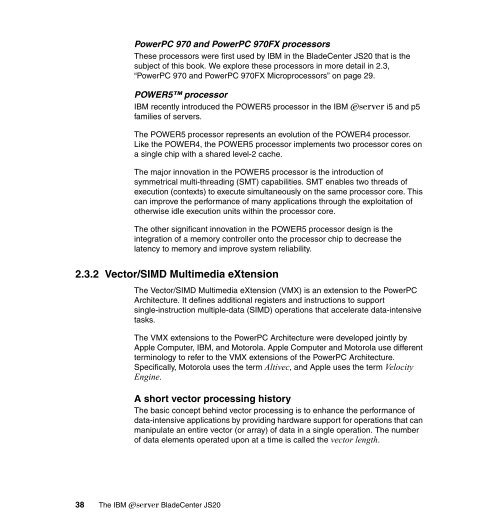The IBM eServer BladeCenter JS20 - IBM Redbooks
The IBM eServer BladeCenter JS20 - IBM Redbooks
The IBM eServer BladeCenter JS20 - IBM Redbooks
You also want an ePaper? Increase the reach of your titles
YUMPU automatically turns print PDFs into web optimized ePapers that Google loves.
PowerPC 970 and PowerPC 970FX processors<br />
<strong>The</strong>se processors were first used by <strong>IBM</strong> in the <strong>BladeCenter</strong> <strong>JS20</strong> that is the<br />
subject of this book. We explore these processors in more detail in 2.3,<br />
“PowerPC 970 and PowerPC 970FX Microprocessors” on page 29.<br />
POWER5 processor<br />
<strong>IBM</strong> recently introduced the POWER5 processor in the <strong>IBM</strong> Eserver i5 and p5<br />
families of servers.<br />
<strong>The</strong> POWER5 processor represents an evolution of the POWER4 processor.<br />
Like the POWER4, the POWER5 processor implements two processor cores on<br />
a single chip with a shared level-2 cache.<br />
<strong>The</strong> major innovation in the POWER5 processor is the introduction of<br />
symmetrical multi-threading (SMT) capabilities. SMT enables two threads of<br />
execution (contexts) to execute simultaneously on the same processor core. This<br />
can improve the performance of many applications through the exploitation of<br />
otherwise idle execution units within the processor core.<br />
<strong>The</strong> other significant innovation in the POWER5 processor design is the<br />
integration of a memory controller onto the processor chip to decrease the<br />
latency to memory and improve system reliability.<br />
2.3.2 Vector/SIMD Multimedia eXtension<br />
<strong>The</strong> Vector/SIMD Multimedia eXtension (VMX) is an extension to the PowerPC<br />
Architecture. It defines additional registers and instructions to support<br />
single-instruction multiple-data (SIMD) operations that accelerate data-intensive<br />
tasks.<br />
<strong>The</strong> VMX extensions to the PowerPC Architecture were developed jointly by<br />
Apple Computer, <strong>IBM</strong>, and Motorola. Apple Computer and Motorola use different<br />
terminology to refer to the VMX extensions of the PowerPC Architecture.<br />
Specifically, Motorola uses the term Altivec, and Apple uses the term Velocity<br />
Engine.<br />
A short vector processing history<br />
<strong>The</strong> basic concept behind vector processing is to enhance the performance of<br />
data-intensive applications by providing hardware support for operations that can<br />
manipulate an entire vector (or array) of data in a single operation. <strong>The</strong> number<br />
of data elements operated upon at a time is called the vector length.<br />
38 <strong>The</strong> <strong>IBM</strong> Eserver <strong>BladeCenter</strong> <strong>JS20</strong>
















